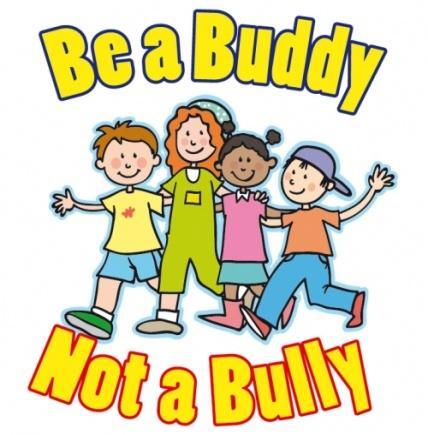Bullying is defined as:“Repeated and unwanted aggressive behavior that occurs over a period of time with an imbalance of power between the bully and the victim.” – Journal of Safe Management of Disruptive and Assaultive Behavior, March 2012
At Fort Calhoun Elementary, we work hard at teaching students strategies on how to deal with others. We empower students to take a stand against bullying behavior. We define bullying and make sure students are aware of what bullying looks like.
The information below is taught and implemented at the elementary building. We strive to keep students informed about bullying through celebrating National Bullying Month, assemblies, conversations, small group activities, and lessons taught throughout the year. There is zero tolerance for bullying. Our motto is, “Be a buddy, not a bully.”

Listed below are common language and definitions on bullying.
Types of Bullying
- Physical – bullying where the body or anything else gets hurt or broken; tell an adult right away.
- Verbal – bullying that uses words to hurt someone. This type of bullying is harder to see and usually happens first. If this is not dealt with, then it grows into physical bullying.
- Cyber – a special type of verbal bullying that uses technology to hurt others: phone calls, texts, Facebook, Twitter. It’s more anonymous – people usually say “meaner” things online than they would face-to-face. However, cyber bullying doesn’t “stay online” because people talk about it the next day.
- Social – when someone uses a relationship to hurt someone. This can occur by making someone feel bad by exclusion, using embarrassing things to make a friend feel bad, and/or ratting or selling out a friend.
Main Roles That People Play
- Bully – bullying is a choice. A bully is someone who needs a little more help figuring out how to make a better choice.
- Target – not a victim because that implies a person is helpless.
- Bystanders – people around when bullying happens – usually they stand and watch; their non-involvement makes the target feel like the bystanders agree with the bully or that they are part of the problem. The bystanders are the people in the situation with the MOST power because every bystander has the potential to be an ally!
- Allies – the people who are ready to do something and stick by the target.
Hot Spots for Bullying at School
- Playground/Recess
- School bus
Additional Information
For more information, please contact the School Psychologist, Janet Goetting, or the Elementary Intervention Specialist, PJ Mallette.
To learn more, access the following websites: Kid Power, Respect 2 All, Nebraska Education: Bullying Prevention.
